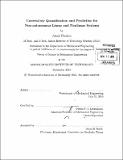Uncertainty quantification and prediction for non-autonomous linear and nonlinear systems
Author(s)
Phadnis, Akash
DownloadFull printable version (19.66Mb)
Other Contributors
Massachusetts Institute of Technology. Department of Mechanical Engineering.
Advisor
Pierre F. J. Lermusiaux.
Terms of use
Metadata
Show full item recordAbstract
The science of uncertainty quantification has gained a lot of attention over recent years. This is because models of real processes always contain some elements of uncertainty, and also because real systems can be better described using stochastic components. Stochastic models can therefore be utilized to provide a most informative prediction of possible future states of the system. In light of the multiple scales, nonlinearities and uncertainties in ocean dynamics, stochastic models can be most useful to describe ocean systems. Uncertainty quantification schemes developed in recent years include order reduction methods (e.g. proper orthogonal decomposition (POD)), error subspace statistical estimation (ESSE), polynomial chaos (PC) schemes and dynamically orthogonal (DO) field equations. In this thesis, we focus our attention on DO and various PC schemes for quantifying and predicting uncertainty in systems with external stochastic forcing. We develop and implement these schemes in a generic stochastic solver for a class of non-autonomous linear and nonlinear dynamical systems. This class of systems encapsulates most systems encountered in classic nonlinear dynamics and ocean modeling, including flows modeled by Navier-Stokes equations. We first study systems with uncertainty in input parameters (e.g. stochastic decay models and Kraichnan-Orszag system) and then with external stochastic forcing (autonomous and non-autonomous self-engineered nonlinear systems). For time-integration of system dynamics, stochastic numerical schemes of varied order are employed and compared. Using our generic stochastic solver, the Monte Carlo, DO and polynomial chaos schemes are inter-compared in terms of accuracy of solution and computational cost. To allow accurate time-integration of uncertainty due to external stochastic forcing, we also derive two novel PC schemes, namely, the reduced space KLgPC scheme and the modified TDgPC (MTDgPC) scheme. We utilize a set of numerical examples to show that the two new PC schemes and the DO scheme can integrate both additive and multiplicative stochastic forcing over significant time intervals. For the final example, we consider shallow water ocean surface waves and the modeling of these waves by deterministic dynamics and stochastic forcing components. Specifically, we time-integrate the Korteweg-de Vries (KdV) equation with external stochastic forcing, comparing the performance of the DO and Monte Carlo schemes. We find that the DO scheme is computationally efficient to integrate uncertainty in such systems with external stochastic forcing.
Description
Thesis: S.M., Massachusetts Institute of Technology, Department of Mechanical Engineering, 2013. Cataloged from PDF version of thesis. Includes bibliographical references (pages 189-197).
Date issued
2013Department
Massachusetts Institute of Technology. Department of Mechanical EngineeringPublisher
Massachusetts Institute of Technology
Keywords
Mechanical Engineering.